By Michael O'Malley
Plain Dealer
December 5, 2010
http://www.cleveland.com/religion/index.ssf/2010/12/bishop_richard_lennon_leader_o.html
[with video]
 |
| Bishop Richard Lennon during installation services at St. John's Cathedral Monday, February 15, 2006. |
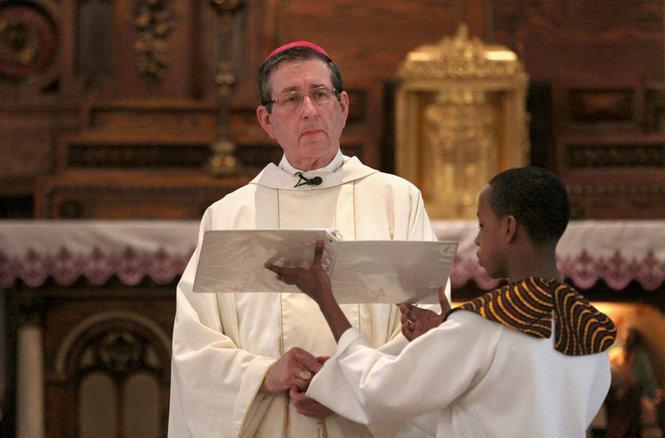 |
| Bishop Richard Lennon conducts the final mass at St. Adalbert Church Sunday, June 6, 2010. St. Adalbert, home to Cleveland's oldest black Catholic congregation, closed it's doors as part of the diocesan downsizing. |
 |
| Bishop Richard Lennon implores a group sitting vigil inside St. John the Baptist to leave the church. The protestors argued with him about the process he used to decide on closing 50 churches in the Cleveland Catholic Diocese. The bishop has repeatedly said his plan is aimed at making the remaining churches viable and vibrant. |
 |
| Bishop Richard Lennon waits to be introduced during a press conference explaining downsizing of the Cleveland Catholic Diocese. |
 |
| Bishop Richard Lennon explains the process used in downsizing the Cleveland Catholic Diocese during a news conference March 15, 2009. |
 |
| Bishop Richard Lennon during installation ceremonies at St. John's Cathedral May 15, 2006. |
 |
| Bishop Richard Lennon listens as Father Paul Rosing reads a court injunction prohibiting protestors from occupying St. John the Baptist Church in Akron after the final Mass was celebrated Saturday. They sat vigil for nearly two hours before police officers showed up and said they would be arrested if they didn't leave. |
 |
| In a 2005 protest over a Catholic school closing in Brighton, Mass., one protester wears a T-shirt portraying Bishop Richard Lennon (center) and two other diocesan leaders as hear-no-evil see-no-evil speak-no-evil. |
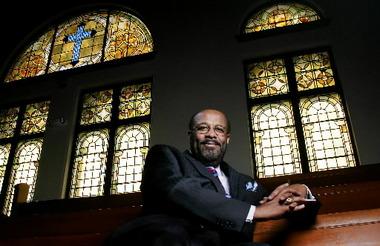 |
| The Rev. Marvin McMickle: "When you close a St. Cecilia's, what happens to the ministry of the church and its witness?" |
 |
| Parishioners from St. Casimir Church walk past Bishop Richard Lennon without greeting him after the closing mass Sunday, November 8, 2009. |
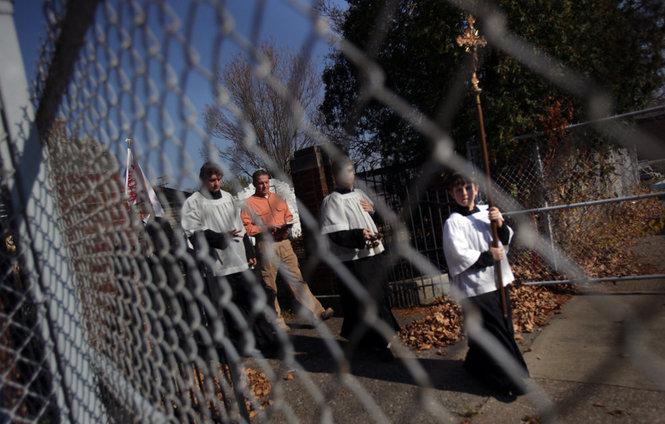 |
| Michael Golab, 11, of Lorain leads a procession around the church rectory to stop the closing of St. Casmir Church. Bishop Richard Lennon would later lead the closing mass at the church. |
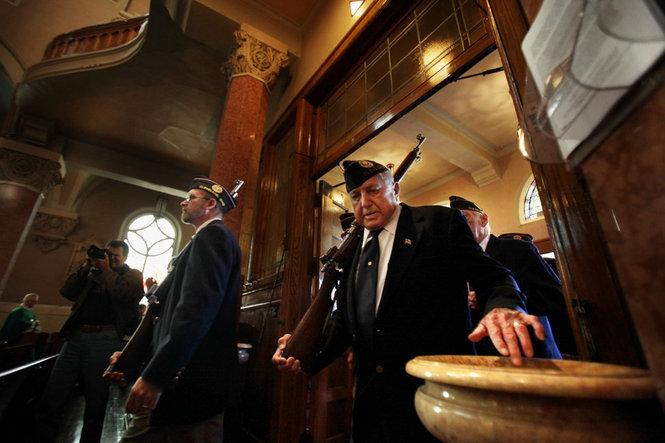 |
| A member of the Polish Legion of American Veterans Post 31 dips his fingers in holy water as the procession makes its way to the front of the church for the final Polish mass at St. Casimir Sunday, November 8, 2009. |
 |
| Fr. John Wachala serves communion during the final Polish mass at St. Casimir. |
 |
| Some of the approximately 100 parishioners from St. Casimir Church walk out of the closing mass led by Bishop Richard Lennon Sunday, November 8, 2009. |
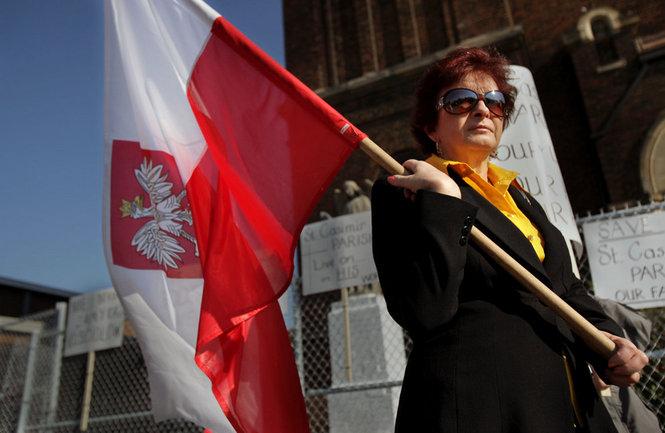 |
| Berndette Zubel, of Parma, holds the Polish flag after the final Polish mass at St. Casimir to protest Bishop Richard Lennon's closing of the church. |
 |
| A worshipper takes a picture of the altar at St. Casimir Church after the closing mass Sunday, November 8, 2009. |
 |
| Parishioners from St. Casimir shout at Bishop Richard Lennon after walking out of the closing mass Sunday, November 8, 2009. Shouts of "go back to Boston" and "Judas" were heard from the crowd. The mass was interrupted on several other occasions with protests and one parishioner cut power to the church's audio system. |
CLEVELAND, Ohio — Even before he was officially installed as the 10th bishop of the Cleveland Catholic Diocese, Richard G. Lennon talked about the need to close churches here.
"As painful as a funeral is, it's there that you commend your loved one to God," Lennon told a news conference announcing his appointment five weeks before his installation in May 2006.
Those words, coming from a man who had just closed scores of churches in Boston, sounded a death knell for dozens more in Northeast Ohio. And those closings unleashed a small but shrill backlash from Catholics throughout Cleveland's eight-county diocese.
Although some of the closings remain under appeal with the Vatican, the most extensive downsizing in the history of the 163-year-old diocese now is essentially over. In the end, 50 parishes -- mostly in inner-city neighborhoods -- were closed. Vacant churches are up for sale, merged parishes are moving forward.
And Lennon must minister to a diocese where emotions remain raw.
Like many U.S. bishops in financially struggling regions, Lennon faced a rapidly changing church when he came to Cleveland in 2006. Membership at urban churches had plummeted, priests were in short supply.
Week after week, Lennon, often in the company of armed police, presided over the closings, saying final Masses that ended with snuffed-out sanctuary lamps and padlocked doors.
The drama -- which ended in June -- was in shocking contrast to the 25-year reign of Lennon's predecessor, Cleveland-born Anthony Pilla, who closed only a dozen churches in that time.
Lennon's defenders say his swift and sweeping approach was needed, because it was glaringly apparent when he came to Cleveland that decades of Catholic flight to the suburbs had left near-empty churches in the city with little money to operate.
And with few men entering the priesthood, his defenders argue, the bishop needed to consolidate urban parishes through closings and mergers, allowing him to reassign some of his shrinking corps of clergy to growth areas.
"He had to look at the whole diocese, not just a few parishes," said the Rev. John Betters, pastor of SS. Robert and William in Euclid, a newly merged parish. "He came into a situation of having too many parishes for the number of Catholics. I certainly wouldn't want to be in his shoes because he had to make some very tough calls."
Making those calls would require an imposing, authoritarian figure to quell any rebellion, and Lennon seemed like just the man.
Views of Lennon depend on perspective
Standing 6-foot-2 and wearing layers of flowing, embroidered robes, the 63-year-old bishop could be an intimidating presence when delivering a parish's last rites in his booming Boston accent.
Nicknamed "The Boston Strangler" by detractors, he usually arrived at a final Mass chauffeured in a staff-driven car and escorted by uniformed and plainclothes police. Protesters, who called it the "Mass of Eviction," once circled his car as his driver edged the vehicle out of the parking lot.
"He showed little compassion," said Patricia Schulte-Singleton, one of a few dozen protesters who followed Lennon from church to church. "And he wanted to let everybody know that he was in charge."
Singleton, head of a protest group called Endangered Catholics, said she once shook Lennon's hand following a church closing and asked him how he was able to sleep at night, given the misery he was inflicting on people.
"With my hand still in his, he pushed my hand away and said, 'Move along,' " Singleton recalls.
Lennon himself has said little publicly about the closings since announcing the downsizing plan in March of 2009. The bishop also declined to be interviewed for this story.
But Betters said the bishop, whom he described as a task-oriented administrator who is demanding of his staff, "is really getting a very bad rap."
"He has listened very carefully to the people," said Betters. "He didn't always agree with them, but he patiently listened."
Those close to Lennon, both in Cleveland and in Boston, described him as a man who lives a no-frills, simple life in the rectory of St. John's Cathedral in downtown Cleveland.
"I find him to be a sensitive, good, holy man," said Betters. "I've seen him in the schools greeting the kids and going out of his way to meet the janitor and the secretaries."
But no one will ever convince parishioner Marilyn Madigan, from the closed St. Patrick's in West Park, that Lennon is sensitive. She said she will never forget how Lennon treated her and other parishioners during a meeting in his office.
When Madigan told the bishop she had followed the advice of her pastor, the Rev. Thomas Hagedorn, regarding procedures for appealing the parish's closing, Lennon "pounded his fist on the table," she said, "pointed his finger at me and said, 'I'm your leader. You listen to me.' "
Ray Murphy, vice chair of the Catholic Diocese of Cleveland Foundation, the money-raising arm of the diocese, said: "You hear these stories that he's an imperious dictator. But I don't see it.
"I think he pushes himself too hard. He's working long hours. But I find him to be very engaging, personable . . . a perfect gentleman."
Foundation board member Patrick Auletta said he admired Lennon for taking on the monumental task of closing churches, knowing it would cause an eruption. He said the bishop told him he had been spat upon and sworn at.
"He realizes the job he has to do has a lot of unpleasantries," said Auletta. "He's not the kind of guy to kick the can down the road and leave it for someone else."
A number of priests contacted by The Plain Dealer declined to discuss the church closings or Lennon's leadership. Others did not return phone messages.
The Rev. Paul Rosing, a member of a priest council that worked with Lennon on the closings, said the diocesan financial picture in the spring of 2007 showed 43 percent of the 224 parishes were operating at a deficit.
Thus began a nearly two-year process of deciding which parishes would merge, close or survive. The work was done by grassroots committees known as clusters, comprised of parishioners and clergy in defined geographic areas.
But Lennon, who had the final say, sometimes made his own calls.
"Did I agree with every closing/merger scenario? No," said Rosing. "Did I agree with 95 percent of them? Yes."
"In the final analysis," Rosing said, "The bishop is the boss and I support the decisions that have been made. We know there's a lot of anger and pain. It's going to take awhile, but we're doing the best we can."
Makes tough decisions, popular or not
Back in Boston, anger and pain continue to seethe six years after Lennon closed parishes there, including his boyhood church built by his working-class ancestors.
Eventually, the 83 closings were reduced to 60, but nine congregations in the archdiocese refused to leave their churches, holding around-the-clock vigils.
In a couple of cases, police, under orders from Lennon and the Catholic hierarchy, began arresting squatters but, faced with public outcry and media coverage, the archdiocese called off the forces.
In 2005, the archdiocese waved a white flag and reopened four of the nine occupied churches. Today, six years later, five remain under occupation.
"This is all due to the Machiavellian hand of Richard Lennon," said Mary Beth Carmody, a leader of the still-occupied St. Jeremiah in Framingham, Mass. "He left a legacy of pain and harm to the Catholics of this archdiocese."
Another Boston parish under occupation is St. Frances Cabrini in Scituate, Mass., which sits on a 30-acre bluff overlooking Cape Cod Bay.
Parishioner Jon Rogers believes the archdiocese, struggling with debt from the clerical sex-abuse scandals, sees the prime real estate as a cash cow.
"It's just a giant land grab," he said. "It's about the Almighty. The Almighty Buck."
Rogers described a confrontation at St. Frances between Lennon and a few parishioners. "He told us to get off the property," he said. "The guy's brutal. He's arrogant and condescending. My condolences to the fine people in Cleveland. He's your problem now, not ours."
However, Lennon is not without defenders in Boston.
"The tragedy was that he was thrown into a daunting perfect storm -- the criminality of the sex abuse cases and the unstable finances of the archdiocese," said the Rev. Bruce Teague who had worked in a Boston hospital during Lennon's reign and is now in another Massachusetts diocese.
"People I know have a great love and affection for him. He was seen as a man with a difficult job. And I think he did the best he could under an impossible situation. I'm not trying to whitewash the guy. I just see a different level of him."
David Castaldi, former chancellor and chief financial officer of the Boston archdiocese, described Lennon as "a man of outstanding integrity."
"I've worked very closely with him," he said. "I know him as a human being. He's a regular kind of guy. He's got a good sense of humor."
Castaldi, a businessman in the health care field, supported the downsizing of the archdiocese, but he criticized Lennon and the hierarchy for not giving the laity a bigger role in the closing process.
"Bishop Lennon is a man who can make tough decisions," said Castaldi. "And tough decisions can make a person unpopular. After the church closings, he became increasingly unpopular."
Lennon once told Castaldi he wished to be back in parish work. The bishop echoed that wish in October in a speech in Akron. "To be very honest, I would prefer to be in a parish," Lennon told a First Friday Club of Greater Akron luncheon. "That's where my heart is, and that's where I left it 22 years ago.
"There's nothing like being a part of people's lives, baptizing a baby or even burying the dead and things in between. In my job, I don't get to do that very much."
Hard work made him a bishop
Lennon grew up in Arlington, Mass., in an Irish Catholic family that prayed the rosary daily and attended Sunday Mass at St. James the Apostle where the young Lennon was an altar boy.
In school, he was quiet and studious, embarrassed by a stutter that he would eventually overcome years later in the seminary.
Lennon was ordained in 1973 and served in parishes in the Boston archdiocese. In 1988, Boston's Cardinal Bernard Law moved Lennon into the chancery as chief canon law expert. In 1999, Law appointed him rector of St. John's Seminary.
Known for his obsession with work and regimentation, Lennon was elevated to auxiliary bishop in 2001 by Pope John Paul II.
And when Law, embroiled in the clerical sex-abuse crisis, resigned in disgrace in 2002, the pope named Lennon as the interim head of the archdiocese, a move that shocked lots of Catholics.
"Raw determination has fueled the rise of Richard Gerard Lennon to his present, unsought prominence," the Boston Globe wrote. "Lennon's willpower, analytical bent and capacity for hard work have helped him surpass colleagues of greater charisma or careerism and build a reputation as a man who presses past obstacles where others might stop."
Closed many churches, including his own
Two Cleveland clerics, the Rev. Bob Begin, a Catholic priest, and the Rev. Kenneth Chalker, a Methodist minister, have openly criticized Lennon over the closing of so many inner-city churches -- about 70 percent of the 50.
Begin, who has worked with inner-city poor people for more than 40 years, is the only Catholic priest in the diocese to publicly challenge the bishop.
Chalker, who in an interview called Lennon a "meat cleaver" and has appealed to Vatican hierarchy to remove him from Cleveland, claims that the bishop has unraveled the interfaith and ecumenical work of his predecessor Bishop Pilla.
The diocese, responding to Chalker's accusations in a Plain Dealer story in September, denied all of his claims. And Murphy, of the diocese foundation, noted this week that Catholic Charities and the diocese's social programs help people of all faiths.
But other non-Catholic clerics agree with Chalker.
"He hasn't been engaged in the interfaith community nor the larger community of Greater Cleveland, as was Bishop Pilla, who was one of our most significant clergy leaders," said Rabbi Richard Block of Temple-Tifereth Israel in Cleveland and Beachwood.
The Rev. Marvin McMickle, pastor of Antioch Baptist Church, said he and Pilla would dine together at each other's homes, meet in each other's offices and participate together in community events.
McMickle said he has never met Lennon, "And it's not because of me."
McMickle noted that in one of the poorest sections of Cleveland, Lennon closed three African-American churches -- Epiphany, St. Cecilia and St. Adalbert -- basically wiping out the black Catholic presence in the city.
"When you close a St. Cecilia's, what happens to the ministry of the church and its witness?" McMickle questioned. "And what happens to the neighborhood in terms of stability?"
During the closings, a few dozen protesters tried to save some of the churches through petitions, appeals and pickets.
One congregation, St. Peter's in downtown Cleveland, made up of about 300 suburban residents and their pastor, broke away from the diocese and has been worshiping in rented commercial space, defying the bishop and church law.
But most of the diocese's 750,000 Catholics, most of whom live in suburbs unaffected by the closings, kept quiet.
In cases where churches merged, some people refused to go to a new place of worship and drifted away from the faith. Others welcomed the mergers.
"We're going to come out stronger and more vibrant," said Betters of SS. Robert and William, who suggested that, because of the anger and pain over the closings, it might take 10 years to heal and restore the diocese.
Lennon, who reversed two of his closing orders -- St. Colman and St. Ignatius of Antioch, both on Cleveland's West Side -- has repeatedly claimed the downsizing was necessary because of shortages of priests and collection-basket offerings and a change in demographics.
Those are the challenges facing the Catholic Church in the Rust Belt and older cities in the Northeast. Catholics have migrated to developing cities in the South and West and ethnic identities are not as strong as they once were.
"In the older cities, they built a church every two blocks," said Sister Mary Ann Walsh, spokeswoman for the United States Conference of Catholic Bishops in Washington, D.C. "Now dioceses have many churches with no people attending them."
Correcting those imbalances, she said, is the responsibility of the bishops.
"The bishop has to be a good steward of the resources of the diocese," said Walsh. "You don't want to heat four buildings when you only need one. It's a bishop's decision how to best go about reorganizing a diocese."
Lennon, at times, faced hostile parishioners when he showed up to say last Masses. Other times, he was received with respect.
At St. Casimir's in Cleveland, hecklers shouted "Judas!" and worshipers interrupted the service, singing hymns in Polish. A man in his 90s pulled the plug on the bishop's microphone.
At Sacred Heart of Jesus Hungarian Catholic Church in Akron, he found himself engulfed by shouts of anger and ridicule. The turmoil inside the church was videotaped and posted on YouTube.
"Do you really believe I like doing this?" Lennon asks in the video. The crowd responds, "Yes!"
"What joy does it bring me?" he asks. The crowd shouts, "Money!"
"Please," Lennon says. "I don't get anything."
The bishop continues: "I certainly understand people who are very sad and people who are very angry. I am not without sensitivity." The crowd laughs, prompting Lennon to hold up his hands and say: "You may laugh as you wish.
"I did something that none of you have done," he continues. "I closed my own parish. Because as a man of God I believe it was the right thing to do for the mission that Jesus Christ has given us."
To reach this Plain Dealer reporter: momalley@plaind.com, 216-999-4893
Any original material on these pages is copyright © BishopAccountability.org 2004. Reproduce freely with attribution.